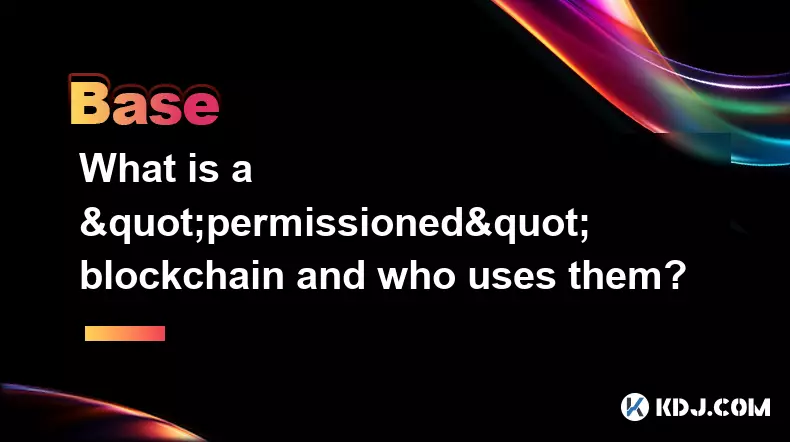-
 bitcoin
bitcoin $101752.865364 USD
-1.09% -
 ethereum
ethereum $3382.985899 USD
-1.38% -
 tether
tether $0.999658 USD
0.04% -
 xrp
xrp $2.272505 USD
-1.51% -
 bnb
bnb $989.089004 USD
0.14% -
 solana
solana $156.962612 USD
-3.08% -
 usd-coin
usd-coin $0.999776 USD
0.01% -
 tron
tron $0.290786 USD
-0.69% -
 dogecoin
dogecoin $0.174594 USD
-2.86% -
 cardano
cardano $0.560085 USD
-3.55% -
 hyperliquid
hyperliquid $40.023704 USD
-5.75% -
 chainlink
chainlink $15.324649 USD
-2.78% -
 bitcoin-cash
bitcoin-cash $493.576540 USD
-3.52% -
 zcash
zcash $571.320038 USD
-12.05% -
 stellar
stellar $0.280066 USD
-4.26%
What is a "permissioned" blockchain and who uses them?
Permissioned blockchains offer controlled access, enhanced privacy, and efficient consensus, making them ideal for enterprises needing secure, compliant, and scalable solutions.
Nov 09, 2025 at 02:39 am

Understanding Permissioned Blockchains
1. A permissioned blockchain operates under a controlled environment where access is restricted to specific participants. Unlike public blockchains that allow anyone to join and validate transactions, these networks require authorization for users to participate in consensus or view data.
2. The validation process in permissioned systems relies on pre-approved nodes. These nodes are typically operated by known entities who have undergone identity verification, ensuring accountability and reducing the risk of malicious activity.
3. Consensus mechanisms in permissioned blockchains are often more efficient than those used in public chains. Since fewer nodes are involved and trust among participants is assumed to some degree, transaction finality can occur rapidly without extensive computational work.
4. Data privacy is a key feature of permissioned blockchains. Organizations can structure the network so that only certain parties can access specific information, making it suitable for handling sensitive business records or regulated financial transactions.
5. Smart contract functionality exists on many permissioned platforms but is usually tailored to enterprise needs. These contracts execute within a governed framework, allowing organizations to automate processes while maintaining compliance with internal policies and external regulations.
Key Users of Permissioned Blockchains
1. Financial institutions leverage permissioned blockchains to streamline interbank settlements and trade finance operations. By using a shared ledger with restricted access, banks can reduce reconciliation time and enhance transparency among trusted partners.
2. Supply chain enterprises deploy these networks to track goods across complex logistics routes. Companies like manufacturers, shipping providers, and retailers gain real-time visibility into product movement while keeping commercial details confidential from competitors.
3. Government agencies utilize permissioned blockchains for identity management and land registry systems. Controlled access ensures data integrity and prevents unauthorized tampering while enabling secure citizen services.
4. Healthcare organizations adopt this technology to manage patient records securely. Authorized medical providers can access critical health data during emergencies, but strict permissions prevent misuse or exposure to unrelated parties.
5. Energy companies use permissioned ledgers to coordinate distributed energy resources and peer-to-peer trading. Participants in microgrids verify energy production and consumption data without exposing proprietary operational metrics.
Technology Platforms Driving Enterprise Adoption
1. Hyperledger Fabric, hosted by the Linux Foundation, is one of the most widely adopted frameworks for building permissioned blockchains. Its modular architecture supports pluggable consensus and membership services, ideal for diverse industry applications.
2. R3 Corda focuses on financial services and enables direct transaction settlement between parties without broadcasting data network-wide. Transactions are validated only by relevant participants, enhancing confidentiality.
3. Quorum, originally developed by JPMorgan, combines elements of Ethereum with privacy-preserving features. It allows private transactions alongside public ones on the same network, catering to institutional requirements.
4. Enterprise Ethereum Alliance (EEA) members collaborate to adapt Ethereum’s capabilities for private deployments. Customizable permissioning layers enable businesses to harness smart contracts in compliant environments.
5. Digital Asset’s platform provides tools for modeling and executing high-assurance financial workflows. Institutions use it to digitize instruments such as bonds and derivatives with precise legal enforceability.
Permissioned blockchains provide organizations with enhanced control over data access, improved transaction speed, and regulatory alignment—making them essential for industries requiring both security and efficiency.
Frequently Asked Questions
How does a permissioned blockchain differ from a private blockchain?A permissioned blockchain refers to any network—whether private or consortium-based—where participants must be authorized to perform specific roles. A private blockchain is a type of permissioned system owned and operated by a single entity, whereas permissioned networks can also include multi-organization consortia with shared governance.
Can smart contracts run on permissioned blockchains?Yes, smart contracts operate on many permissioned platforms such as Hyperledger Fabric and Quorum. They are configured to execute under defined access rules, ensuring that only authorized parties can trigger or view contract logic and outcomes.
Are permissioned blockchains decentralized?They offer limited decentralization compared to public chains. While multiple nodes may validate transactions, the number is smaller and participants are known entities. This design prioritizes performance and compliance over full distribution.
Why do companies choose permissioned over public blockchains?Organizations opt for permissioned systems to meet regulatory obligations, protect sensitive data, and maintain operational control. Public blockchains, though transparent and open, lack the privacy and governance structures required in enterprise settings.
Disclaimer:info@kdj.com
The information provided is not trading advice. kdj.com does not assume any responsibility for any investments made based on the information provided in this article. Cryptocurrencies are highly volatile and it is highly recommended that you invest with caution after thorough research!
If you believe that the content used on this website infringes your copyright, please contact us immediately (info@kdj.com) and we will delete it promptly.
- Ripple (XRP) in 2026: Hold or Fold? A Look at XRP's Future and Emerging DeFi Alternatives
- 2025-11-08 18:35:01
- Zcash ZEC Coin Price Explosion: From Privacy Niche to Center Stage
- 2025-11-08 18:55:01
- Berachain Price Prediction: Navigating the Honeycomb Hype in Crypto
- 2025-11-08 18:55:01
- Arthur Hayes, Gold, and Bitcoin: A Modern Monetary Trinity?
- 2025-11-08 19:15:01
- Shiba Inu's Next Move: Navigating a Shifting Market
- 2025-11-08 19:20:01
- Pakistan's Crypto Crossroads: Balancing Opportunity with Asset-Backed Realities
- 2025-11-08 19:20:01
Related knowledge

What is a "crypto airdrop farmer" and what strategies do they use?
Nov 09,2025 at 03:39pm
What Is a Crypto Airdrop Farmer?1. A crypto airdrop farmer is an individual who actively participates in blockchain projects to qualify for free token...

How does a crypto insurance protocol work?
Nov 08,2025 at 12:39am
Understanding Crypto Insurance Protocols1. A crypto insurance protocol operates by offering financial protection against losses incurred from digital ...

What is token composability and why is it called "DeFi Legos"?
Nov 09,2025 at 06:39am
Bitcoin's Role in Decentralized Finance1. Bitcoin remains the cornerstone of decentralized finance, serving as a benchmark for value and trustlessness...

What is an "exploit" versus a "hack" in the context of smart contracts?
Nov 09,2025 at 12:40am
Understanding Exploits in Smart Contracts1. An exploit refers to the utilization of a known vulnerability within a smart contract’s code to gain unint...

What is a decentralized storage network and how does it compare to cloud services?
Nov 07,2025 at 11:59pm
Understanding Decentralized Storage Networks1. A decentralized storage network distributes data across a peer-to-peer infrastructure rather than relyi...

What is a "generalized frontrunner" bot and how does it operate?
Nov 09,2025 at 02:00pm
Understanding the Generalized Frontrunner BotA generalized frontrunner bot is an automated trading program deployed on blockchain networks, particular...

What is a "crypto airdrop farmer" and what strategies do they use?
Nov 09,2025 at 03:39pm
What Is a Crypto Airdrop Farmer?1. A crypto airdrop farmer is an individual who actively participates in blockchain projects to qualify for free token...

How does a crypto insurance protocol work?
Nov 08,2025 at 12:39am
Understanding Crypto Insurance Protocols1. A crypto insurance protocol operates by offering financial protection against losses incurred from digital ...

What is token composability and why is it called "DeFi Legos"?
Nov 09,2025 at 06:39am
Bitcoin's Role in Decentralized Finance1. Bitcoin remains the cornerstone of decentralized finance, serving as a benchmark for value and trustlessness...

What is an "exploit" versus a "hack" in the context of smart contracts?
Nov 09,2025 at 12:40am
Understanding Exploits in Smart Contracts1. An exploit refers to the utilization of a known vulnerability within a smart contract’s code to gain unint...

What is a decentralized storage network and how does it compare to cloud services?
Nov 07,2025 at 11:59pm
Understanding Decentralized Storage Networks1. A decentralized storage network distributes data across a peer-to-peer infrastructure rather than relyi...

What is a "generalized frontrunner" bot and how does it operate?
Nov 09,2025 at 02:00pm
Understanding the Generalized Frontrunner BotA generalized frontrunner bot is an automated trading program deployed on blockchain networks, particular...
See all articles





















![The Graph Price Prediction [GRT Crypto Price News Today] The Graph Price Prediction [GRT Crypto Price News Today]](/uploads/2025/11/07/cryptocurrencies-news/videos/690d4df44fe69_image_500_375.webp)




















































